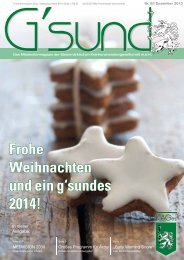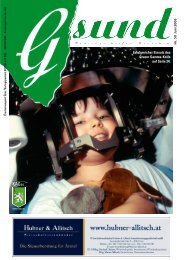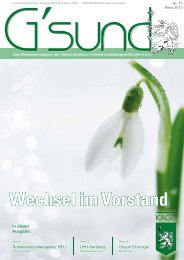Jahresbericht - Gesundheitsserver - Land Steiermark
Jahresbericht - Gesundheitsserver - Land Steiermark
Jahresbericht - Gesundheitsserver - Land Steiermark
Sie wollen auch ein ePaper? Erhöhen Sie die Reichweite Ihrer Titel.
YUMPU macht aus Druck-PDFs automatisch weboptimierte ePaper, die Google liebt.
immediately, without waiting for virological confirmation. This report describes a norovirus outbreak confined<br />
to a nursing home and a related hospital, and assesses the control measures undertaken.<br />
Outbreak Background<br />
On November 16, 2004 the Austrian Agency for Health and Food Safety was contacted by a local public health<br />
officer. He reported the occurrence of ongoing clusters of short-living gastro-enteritis in a nursing home and a<br />
nearby hospital. The latter also affected staff members, causing considerable organisational problems at the<br />
afflicted department. The local health authority created an outbreak management team in order to investigate<br />
and to control the two institutional clusters (responsible public health officer, microbiologist, an epidemiologist,<br />
AGES, the head of the nursing staff of the nursing home and the infection control physician of the hospital. The<br />
objectives of the investigation were to assess the extent of the outbreak, the relation between the two<br />
institutional clusters, to identify the route of transmission, the causative pathogen and to evaluate the control<br />
measures undertaken.<br />
Methods<br />
Definitions:<br />
Outbreak case: Cases in the nursing home were defined as persons having been residing or working there and<br />
who presented at least with one of the two symptoms diarrhoea or vomiting between November 9 and 17. Cases<br />
at the hospital were defined as either persons who have been hospitalised at the Internal Medicine Department<br />
due to illnesses other than gastro-intestinal infection or as hospital staff members who have worked at one of the<br />
two wards of the Internal Medicine Department, and who have developed at least one of the two symptoms<br />
diarrhoea or vomiting between November 11 – 28, 2004.<br />
Household secondary case: Household secondary cases were defined as household members of the cases among<br />
the nursing home staff and Department staff who reported diarrhoea or vomiting between 1 to 7 days after the<br />
corresponding cases had fallen ill. This time period equals the time between the minimum and maximum serial<br />
interval between two successive cases of NV infection.<br />
The attack rate for the nursing home and the Department of Internal Medicine of the hospital were calculated<br />
by the number of cases of the nursing home and of the hospital department, respectively, over the susceptible<br />
population exposed.<br />
The staff-household secondary attack rate was defined as the number of household secondary cases over the<br />
total number of household members exposed to cases of the nursing home staff and the department staff.<br />
Epidemiological investigation:<br />
The following information was obtained from all cases: sex, date of birth, date of clinical onset and cessation,<br />
whether they had vomiting, diarrhea or both and contact pattern. Exposure status to food items eaten within 2<br />
days prior to clinical onset was obtained from all cases of the nursing home. The service staff in the nursing<br />
home was asked whether they had suffered from diarrhea or vomiting between 1 and 7 days prior to the<br />
occurrence of the index case. The persons having visited the index case in the 2 days prior to its clinical onset,<br />
were asked whether they had had symptoms of acute gastroenteritis compatible with NV infection within the 5<br />
days prior to the visit of the index case. The time period of 5 days equals the maximum duration of<br />
infectiousness. Cases of the nursing home staff and the department staff were asked whether short-living<br />
gastroenteritis had occurred in their households between 1 day and 7 days after they had fallen ill. The<br />
information was ascertained either in face-to-face interviews or by telephone interviews with the staff, and by<br />
reviewing patients’ charts for ascertaining information on symptoms and duration of illnesses of the cases<br />
among the residents and hospital patients.<br />
32
















